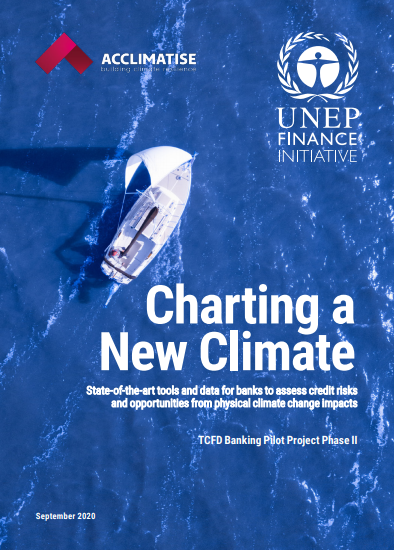UNEP FI launches report on physical climate risks and opportunities
- September 15, 2020
- Posted by: administrator
- Category: Europe

As the climate is changing, extreme events in some parts of the world are becoming more frequent and severe. Their significance varies across geographies and time horizons, between different industry sectors and individual borrowers.
To effectively analyze physical risks to their portfolios, banks need to integrate data on future changes in extreme events (along with data on projected future incremental changes in variables such as temperature and precipitation) into their risk assessment processes.
Phase II of UNEP FI’s Banking Pilot began in 2019 and builds upon the outcomes and findings of Phase I. The Phase I Pilot involved 16 commercial banks and developed initial methodologies for undertaking forward-looking scenario-based assessments of climate risks and opportunities in loan portfolios, in line with the TCFD recommendations. For physical risks and opportunities, it culminated in the publication of “Navigating a New Climate” in 2018.
The new report provides financial institutions with a state-of-the-art blueprint for evaluating physical risks and opportunities. Complete with case studies from participating banks, the report investigates leading practices for five critical topics related to physical risks and opportunities:
Extreme events data and data portals – reviewed examples of climate and climate-related extreme events data and portals from both public (free to use) and commercial data providers.
Portfolio physical risk heatmapping – recognized the benefits of examining total portfolio exposure and identifying where higher physical risks may lie before moving on to ‘deep-dive’ assessments of at-risk portfolio segments.
Tools for physical risk assessment of financial risk – aimed to improve banks’ understanding of commercially-available tools and analytics, as well as training the Phase II banks to use the Phase I Excel-based methodologies.
Physical risk correlation analysis of finance institution portfolios – was developed as banks recognized the value of having a deeper understanding of observed relationships between loan performance metrics and climate-related events.
Analysis of opportunities driven by physical climate risk – aimed to provide insights into the climatic, business, policy and market-led drivers of physical risk-related opportunities.
UNEP FI said that “Charting a New Climate” marks the beginning, not the end, of the journey for financial institutions looking to holistically consider physical impacts.
Eric Usher, Head of UNEP FI commented:
“The Phase II TCFD banking pilot reflects a remarkably diverse global cohort of financial institutions. Through the programme, these institutions were able to collaborate with outside experts and with each other to assess physical risks and opportunities, both in their home regions and around the world. Charting a New Climate offers a primer for the wider industry to follow the lead of this trailblazing group.”
Click here to download the report in full.
